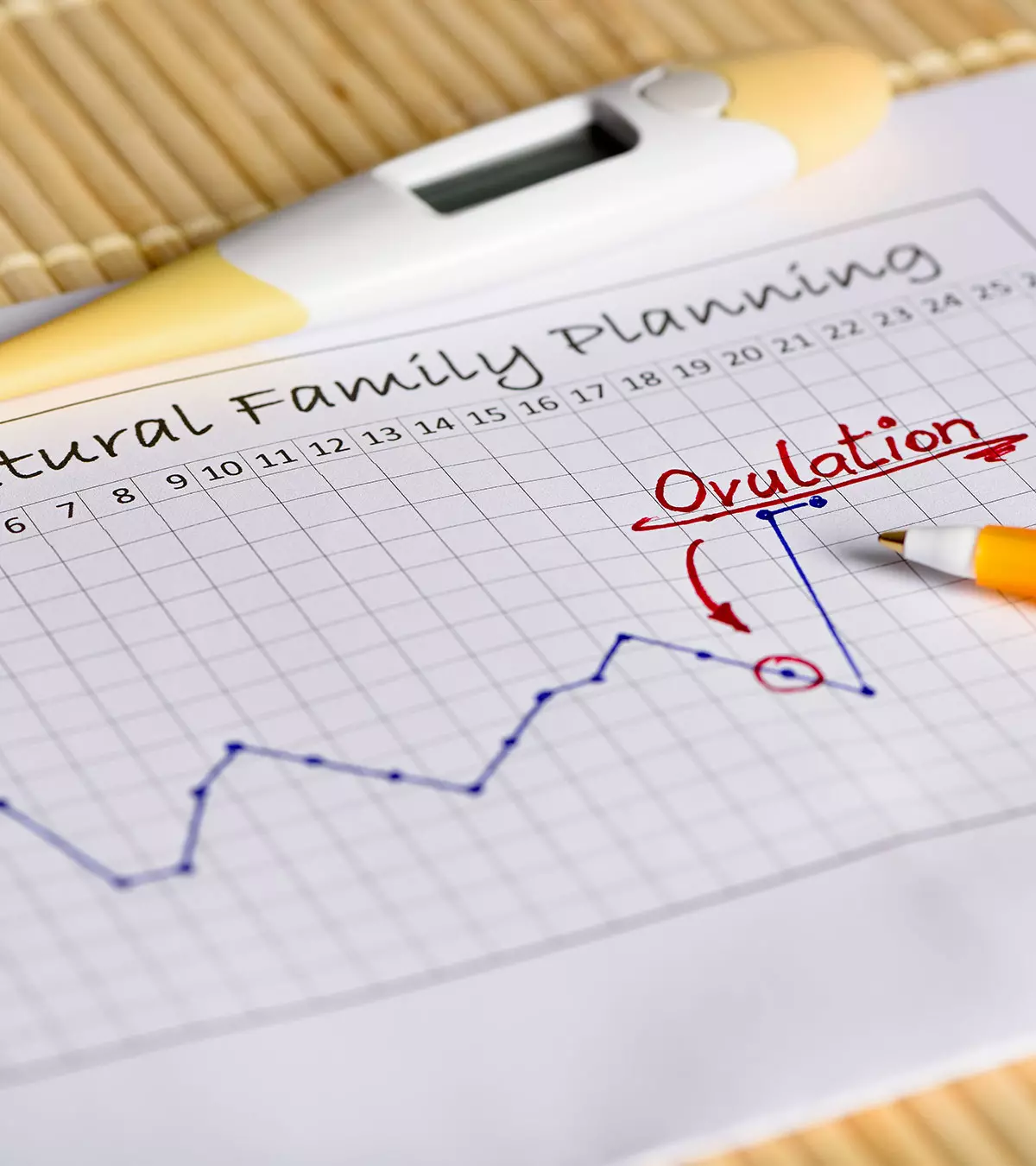

Image: Shutterstock
Natural contraceptive methods are the ones that are used to prevent pregnancy without using medication or contraceptive devices. According to the World Health Organization (WHO), natural these methods are family planning methods that help avoid unwanted pregnancies or plan for pregnancies by identifying the signs and symptoms of the fertile and infertile phases of the menstrual cycle (1). But the question usually arises of whether natural methods are as effective as chemical methods. Read this post to know more about the effectiveness of natural methods of contraception over chemical methods, their benefits, risks, and possible side effects.

What Are The Pros And Cons Of Natural Birth Control?
The natural birth control methods are generally of interest to those couples who do not intend to use artificial contraceptives. The US Department of Health & Human Services (HHS) also describes these methods as fertility awareness-based methods (2) as women or couples become familiar with the signs and patterns of ovulation to avoid pregnancy.
Below are the significant pros and cons of natural birth control methods that are good to know before trying out any natural contraceptive.
Advantages
- These methods can be used either to plan or avoid pregnancy. According to the WHO, there are no physical side-effects of following these methods.
- The HHS states that the natural birth control methods can increase the understanding of your body and its reproductive cycle.
- These methods are comparatively inexpensive and mostly do not require any medical intervention. However, for effective implementation, it is recommended that you talk to your healthcare practitioner.
- In addition, both HHS and WHO state that the use of these methods may enhance communication, cooperation, and involvement between couples.
Disadvantages
- Since these methods are primarily based on fertility awareness, it takes time and effort to keep a daily record of your signs and symptoms. In addition, for women who do not have a regular menstrual cycle, prediction can become tricky.
- These methods do not provide any protection against sexually transmitted diseases (STDs).
- It might take a long time to familiarize oneself with these methods. According to the WHO, the learning period for NFP techniques can be up to three months.
- Moreover, some of these methods require keeping track of cervical mucus discharge and basal temperature. However, according to HHS, vaginal infections, use of antibiotics or antihistamines, and other viral infections can affect these indicators.
What Are The Common Natural Contraceptive Methods?
It is good for you to be aware of the effectiveness of a natural contraceptive method before using it. According to HHS, 25 out of 100 women may get pregnant using NFP methods (2). The rates of effectiveness for these methods vary in different studies. WHO has outlined the effectiveness of a few of these methods (3)
| Natural Birth Control Methods | Effectiveness in Avoiding Pregnancy |
|---|---|
| Calendar rhythm method | · 91% (used correctly and consistently) · 75% (used commonly) |
| Basal body temperature method | · One study reported 88% and the other 75% (used commonly or sometimes incorrectly or inconsistently · 99% (when used correctly and consistently) |
| Symptothermal method | · 98% (used correctly and consistently) |
| Withdrawal method | · 96% (used correctly and consistently) · 73% (used commonly) |
| Lactational amenorrhea method (LAM) | · 99% (used correctly and consistently) · 98% (used commonly) |
Several of the methods listed below rely on recording and interpreting the following parameters or indicators (1) (2).
- Duration of the menstrual cycle: According to HHS, the duration of a menstrual cycle is calculated from the first day of your period to the first day of your next period. Generally, ovulation time is considered the most fertile period.
- Cervical fluid: The cervical fluid characteristics change throughout your cycle. Vaginal area can be dry or have a wet stretchy mucus discharge (raw egg white consistency)
- Basal body temperature: A small rise in body temperature is observed just after ovulation and remains high until the next cycle.
Let us discuss some common natural contraceptive methods.
- Calendar rhythm method: This method is based on estimating the most fertile period from the records of your menstrual cycles of the last six to 12 months.
According to WHO, if you subtract 18 days from the length of your shortest cycle and 11 days from the length of your longest cycle, you will have the earliest and the latest day of your fertile period, respectively (1).
For instance, if your longest cycle length is 32 days and the shortest is 26 days, then your fertile phase will be considered from day 8 to day 21. Therefore, you should try to avoid unprotected intercourse during this period. However, this method provides only a rough estimate (1).
- Basal body temperature method: This method is based on the change in the temperature that occurs after ovulation due to a rise in the progesterone level. Usually, the infertile period begins on the third day after an increase in the temperature is observed.
When taking temperature measurements, record it at the same time every day. WHO recommends that couples who practice this method avoid intercourse until the third day after an increase in the body temperature is recorded (1).
- Mucus inspection method: This method is based on the changes in the consistency of the cervical mucus fluid. Usually, women experience a dry phase just after the menstrual cycle (early infertile phase). Later, they experience a discharge of sticky mucus that is followed by a period when the vagina feels wet. This day is considered the peak day (last day of wetness).
As the progesterone levels rise after the peak day, the mucus again gets thicker or disappears, leading to a dry phase (late infertile phase).
According to the WHO, the fertile phase begins with the appearance of wet mucus and ends on the third day after the peak day (1). Therefore, WHO recommends that couples trying to avoid pregnancy abstain from sex during this period as well as on consecutive days during the early infertile phase (1). You may probably get this right after observing for three to six months.
- Symptothermal method: This method is a combination of basal body temperature method and mucus inspection method. Women not only record changes in the cervical fluid consistency and basal body temperature but also keep track of other bodily changes such as breast tenderness, ovulation pain or spotting, etc.
Couples practicing this method should avoid sex from the day women observe wet mucus until the third day of increased temperature or the fourth day after the peak day (of mucus), whichever is later (1).
- Ovulation indicator testing kits: Ovulation kits are based on the detection of luteinizing hormone (LH) that increases one or two days before ovulation. This can help couples decide when to avoid intercourse.
Most of these kits come with a limited number of tests, which sometimes may not be helpful as you may not know from which timeframe you should start testing, especially if you do not have regular cycles. Moreover, in many women, an increase in LH is observed even when the egg hasn’t been released.
Therefore, the American Pregnancy Association (APA) suggests women start using ovulation kits once they observe changes in cervical mucus (as discussed in mucus inspection method) (4). According to APA, these kits can be effectively used in combination with basal body temperature and mucus inspection method (4).
- Withdrawal method: In this method, during intercourse, the partner pulls out before ejaculation. Therefore, it doesn’t allow semen to reach the vagina, avoiding fertilization as the sperm does not reach the egg.
However, according to HHS, this method doesn’t work well when the partner is less experienced in using this method or may have difficulty in identifying the right time to withdraw before ejaculation (5). Planned Parenthood suggests that this method works well when used with other methods of birth control (condoms, pills, etc.) (6).
- Lactational infertility: Also known as the lactational amenorrhea method (LAM), this method is for new mothers. HHS states that this method might work if the mother is exclusively feeding breast milk to the baby for six months, and any spotting or bleeding is absent during that period (7).
Also, the breastfeeding needs to be done at least every four hours during the day and every six hours during the night (7). WHO recommends women who are weaning off babies may use mucus inspection and basal body temperature methods to identify the fertile days during that period (1).
- Abstinence: Abstinence involves avoiding intercourse in all forms. According to HHS, abstinence is the only way to avoid pregnancy effectively (8). However, it is essential to communicate with your partner about refraining from sexual intercourse during the required period.
Some women may consider vaginal douching to prevent pregnancy. Vaginal douching is the process of cleaning vaginal area with liquid solutions. Various studies discourage douching and have found an association between douching and vaginitis, pelvic inflammatory disease, and ectopic pregnancy (9).
The American College of Obstetricians and Gynecologists (ACOG) states that douching can alter the pH of the vagina, leading to vaginitis (10). Interestingly, according to the Office on Women’s Health, HHS, douching doesn’t avoid pregnancy and can increase the risk of ectopic pregnancy, low birth weights, and lead to a decrease in fertility (11).
Along with natural contraceptive methods, certain herbs have been in use for birth control.
Herbs For Natural Birth Control
Herbal birth control methods are based on indigenous knowledge or folklore. There are no FDA-approved or clinically-tested herbs for contraception. The safety and effectiveness of contraceptive herbs thus cannot be established. It is advised to consult your healthcare practitioner about using herbs as a natural birth control method.
Below are some herbs used in different cultures and geographies (12) (13) .
- Wild carrot (Queen Anne’s lace) seeds were used to inhibit implantation.
- Wild yam is believed to work as a contraceptive when taken daily.
- Smartweed (Polygonum hydropiper) leaves are said to be rich in rutin, quercetin, and gallic acid that interfere with pregnancy.
- Neem (Azadirachta indica) is used as a spermicide.
- Castor beans (Ricinus communis) seeds are said to show antifertility activity.
- Mint (Mentha arvensis) leaves are believed to have spermicidal properties.
Is It Possible To Avoid Pregnancy Naturally By Eating Certain Foods?
There are no directives from premier organizations (including USFDA) on foods that can naturally help you avoid pregnancy. In popular belief across different regions and cultures, the following food items are said to contain abortifacient properties (14)
(15) (16).
- Pawpaw
- Papaya (Carica papaya)
- Jackfruit
- Pineapple
Is It Okay To Be On Natural Birth Control For A Long Time?
There is no evidence to state that natural birth control methods can be harmful or harmless when implemented for a long time. It may be unlikely that these methods cause harm since they do not involve the use of medications. However, it is ideal to consult a doctor if you plan to use natural birth control methods for a long time.
Frequently Asked Questions
1. Is natural birth control better?
Natural birth control posing no side effects can prove to be a safer and better alternative to artificial birth controls if used correctly (17).
2. What is the difference between natural and artificial contraception?
The primary difference between natural and artificial contraception lies in their definition and types. Naturals are the ones that do not involve any medication or devices, while artificial ones can be hormonal and non-hormonal involving pills, IUDs, and condoms (18).
3. Is the natural method of contraception safe?
Yes, natural methods of contraceptives such as withdrawal, calendar rhythm method, and ovulation indicator are safe forms of contraception without any adverse side effects (17).
Natural contraceptive methods are an alternative for those who don’t want to use artificial contraceptives to prevent pregnancy. Although these methods are inexpensive and have no physical side effects, their success in pregnancy prevention is relatively low. Besides, they don’t offer protection against sexually transmitted diseases. Thus, it is advisable to opt for a natural contraceptive method only after consulting with your doctor. Your doctor can guide you through the pros and cons of each method and help you make an informed decision.
References
1. Natural Family Planning: World Health Organization (1988)
2. Natural Family Planning and fertility Awareness: U.S. Department of Health & Human Services. (2019)
3. Family Planning/Contraception: World Health Organization. (2018)
4. Ovulation Tests: American Pregnancy Association. (2019)
5. Withdrawal: U.S. Department of Health & Human Services. (2019)
6. Withdrawal (Pull Out Method): Planned Parenthood. (n.d.)
7. Lactational Amenorrhea Method (LAM): U.S. Department of Health & Human Services. (2019)
8. Abstinence: U.S. Department of Health & Human Services. (2019)
9. Martino, J. L., & Vermund, S. H. Vaginal douching: evidence for risks or benefits to women’s health: Epidemiologic reviews, 24 (2), 109-124. (2002).
10. Technical bulletin—vaginitis: The American College of Obstetricians and Gynecologists; Washington, DC: (1996).
11. Douching: Office on Women’s Health, U.S. Department of Health & Human Services. (2019)
12. Ravichandran, V., Arunachalam, G., Subramanian, N., & Suresh, B. Contraception and its significance in Traditional System of Medicines: International journal of pharmaceutical sciences, 1(1), 1-21. (2009).
13. Kaur, R., Sharma, A., Kumar, R., & Kharb, R. Rising trends towards herbal contraceptives: J Nat Prod Plant Resour, 1 (4), 5-12. (2011)
14. Meyer-Rochow, V. B. Food taboos: their origins and purposes: Journal of ethnobiology and ethnomedicine, 5(1), 18. (2009)
15. Adebiyi, A., Adaikan, P. G., & Prasad, R. N. V. Papaya (Carica papaya) consumption is unsafe in pregnancy: fact or fable? Scientific evaluation of a common belief in some parts of Asia using a rat model: British Journal of Nutrition, 88 (2), 199-203. (2002)
16. Nag, M. Beliefs and practices about food during pregnancy: implications for maternal nutrition: Economic and political weekly, 2427-2438. (1994)
17. Raymond McVeigh (2013); Artificial and Natural Forms of Birth Control: A Comprehensive Analysis: Grand Valley State University ScholarWorks
18. What contraceptive is suitable for me: The Aga Khan University
Community Experiences
Join the conversation and become a part of our nurturing community! Share your stories, experiences, and insights to connect with fellow parents.
Read full bio of Dr. Sangeeta Agrawal
Read full bio of Rebecca Malachi















